Confused about 6-pin, 8-pin, and 12-pin GPU power supplies? If so, this article is for you. Later in this article, we shared everything you need to know about these types of GPU Power Connectors.
Power consumption is one of the most important factors to consider when a gamer builds a PC. However, users often overlook this factor on top-of-the-line graphics cards. For an immersive gaming experience on their PC, they install top-notch graphics cards. These graphics cards overload the power supply and make life difficult for gamers.
With a top-tier GPU attached to your PC’s motherboard, you’ll need fast data transfers when playing games. On a standard PC, the connector that connects the GPU to the motherboard usually doesn’t have the required number of pins to provide higher power. Missing some pins strains the motherboard and renders the whole circuit non-functional.
An entry-level graphics card needs 150W of power from the motherboard to run smoothly. In contrast, a standard PCIe x16 slot only provides 75W of power. So if you expect the performance you need from your PC, you need a high performance GPU power connector.
NVIDIA’s recent announcement of a 12-pin power connector for the new RTX 30 series has fascinated users wanting to know the exact difference between the 6-pin, 8-pin, and 12-pin power connectors. Therefore, this guide will explain the differences between all GPU pin headers.
Table of Contents
What Is A PCIe x16 Connector?
PCIe in processors is an interface standard that connects many ultra-high-speed components for high-speed data transfers using power from the motherboard. Every computer or motherboard has PCIe slots that allow users to connect GPUs, SSDs, and RAID cards.
You can find PCIe in various physical configurations. Includes PCIe x1, PCIe x2, PCIe x4, PCIe x8, and PCIe x16. PCIe x16 is the best type of PCIe for gaming PCs and GPUs. There are 16 tracks that transfer data at 16 bits per cycle.
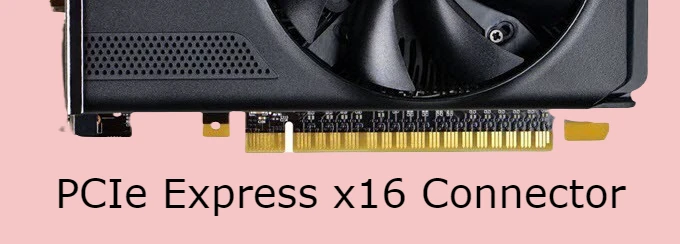
Standard processor motherboards now have a PCIe x16 slot. This connector above has 16 slots for powering the GPU. In a PCIe x16 slot, the maximum power you can expect is 75W. Using high-end graphics cards such as the RTX 3080 can strain your motherboard and consume more power.
Some processors come with multiple PCIe x16 slots. This allows users to use more GPUs in their system. However, this ultimately increases the overall system power consumption.
A PCIe x16 slot can accommodate GPUs that typically don’t require more than 75W of power. These GPUs include the GTX 1050 2GB, GTX 1030, RX 550 and 460. These GPUs do not require more than 75W of power.
PCIe x16 also has different types of slots available on motherboards. A true PCIe x16 slot will always have 1×16 lanes on the motherboard and offer 16 bits of data transfer per cycle. However, cheaper motherboards have two 8-lane PCIe slots, allowing 8-lane bandwidth.
What Is A 6-Pin GPU Cable?
6-pin graphics connectors are commonly used in low-end and mid-range graphics devices. As the name suggests, the connector features 6-pin connection slots with a 4.2mm pitch. These GPU connectors can draw up to 75W directly from an external power supply. Power bypasses the motherboard. A 6-pin GPU connector is suitable if your graphics card requires at least 150W of power.
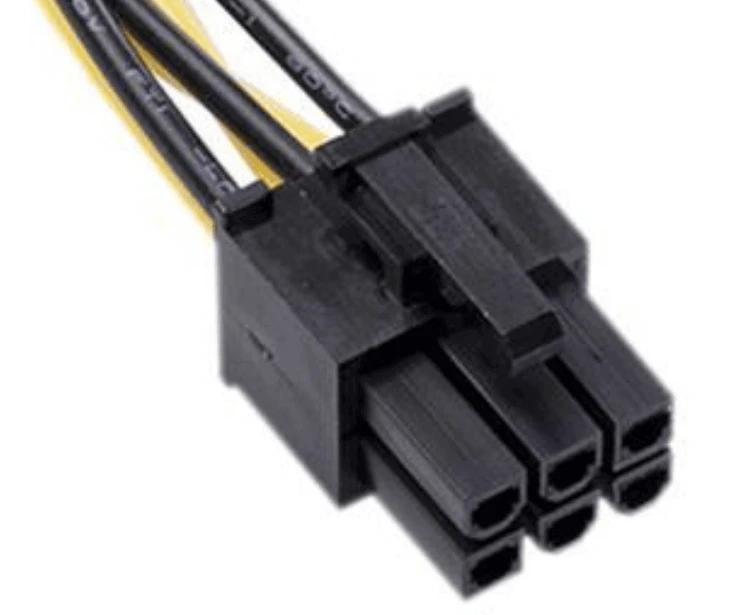
In such case, the graphics card draws 75W from the PCIe x16 connector and another 75W from the 6-pin connector. The 150 Watt power supply is accurate and more than expected for some GPUs. However, there are also graphics cards with 320 or 750 watts of power. These are typically high-performance, power-hungry GPUs that require power to transfer data at lightning speed.
Graphics cards that can easily use a 6-pin power supply are the GTX 1060 and GTX 1650. The power consumption of these two graphics cards is 120W and 100W respectively. Graphics cards often have two 6-pin connectors. The two 6-pin connectors provide 150W of power, and the PCIe x16 slot provides an additional 75W. So the total power they receive is 225 watts.
What Is An 8-pin GPU Cable?
The 8-pin GPU cable is a common power connector on most high-end graphics adapters. These connectors typically have a 4.2mm pitch and can deliver 150W of power without issue. If you use the 8-pin connector to connect your graphics card, the maximum power you can get is 225W. You get 75W from the PCIe x16 slot and 150W from the 8-pin header.
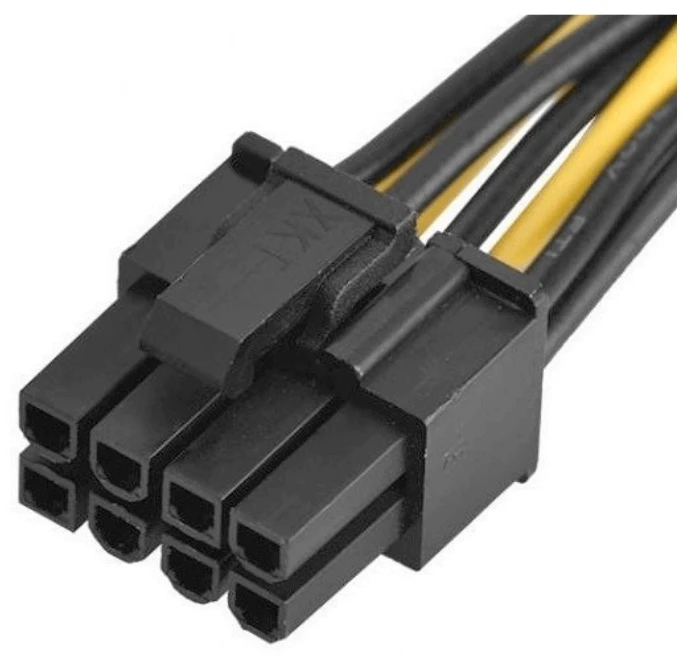
However, you can never go wrong when connecting a 6-pin connector to an 8-pin connector. Generally, 6-pin GPU cables are rated at 75W only. But when you plug it into an 8-pin connector, it tries to draw more power with the efficiency of the 8-pin connector. This eventually creates a fire hazard and causes the system to crash.
A solution to this problem is to use a combination of connector types and cables. The 6+2 connector type is the most common connector type available. You can plug a 6-pin cable into the 6-pin connector and pull out 150W instead of 75W. Additionally, the 6 + 2 connector cable is also rated at 150W for a 6-pin cable without ignition.
High-end graphics systems may have some connectors that are not commonly used. This allows users to get maximum power without stressing the motherboard or connecting cables. However, this also has its drawbacks. Using more cables will restrict airflow to the processor and cause overheating.
What Is A 12-Pin GPU Cable?
The 12-pin GPU cable is the latest developed by the NVIDIA graphics company. The connectors on these cables are 3.0mm pitch. This means that the actual physical size is the same as an 8-pin connector, and it also takes up less internal airflow space. The 12-pin connector design is simple and not too difficult. One row is for power and the other is for ground.

A pin with 18 AWG wire can power up to 500w instead of directly on the motherboard Premium premium pin with 16 AWG and efficiency up to 600w in some cases You can find manufacturers that provide GPU cables.
The reason NVIDIA uses a 12-pin cable for GPUs is to provide more power to the GPU along with constant cooling. The new 12-pin GPU cable is more compact and the same size as the 8-pin cable. This saves space and improves cooling for next-generation graphics systems.
The new NVIDIA RTX 3000 series is 12-pin compatible. Ultimately, NVIDIA needed a cable to power the GPU externally, so they developed an efficient cable system. Energy-intensive graphics solutions were therefore accompanied by rather compact solutions.
Since the introduction of the 12-pin connector, NVIDIA has also worked on power supplies below the 12-pin connector. So he also released an adapter with two x6 pin connectors.
Adapters Or Converters For Connectors
Compatibility issues arise when gamers build PCs. The same is true when connecting components. You may find power connectors that are incompatible with your motherboard or other computer hardware. Undoubtedly, computers around the world are made by different brands and engineers.
In most cases, you can change the type or design of the equipment if it is not convenient for you. In such cases, connecting external components provided by third parties cause many compatibility issues. Additionally, connecting a new GPU to an older PSU will also introduce connectivity and compatibility issues. This is where adapters and converters come to the rescue.
Adapters and converters help users seamlessly connect new-generation GPUs to older power supplies. Easily use these connectivity adapters to ensure compatibility with high-performance GPUs. These adapters are often referred to as Molex adapters/Molex converters. Here are the adapters or converters you can use to match your desired pin header.
1. 4-Pin Molex To 6-Pin PCI-E Adapter Cable
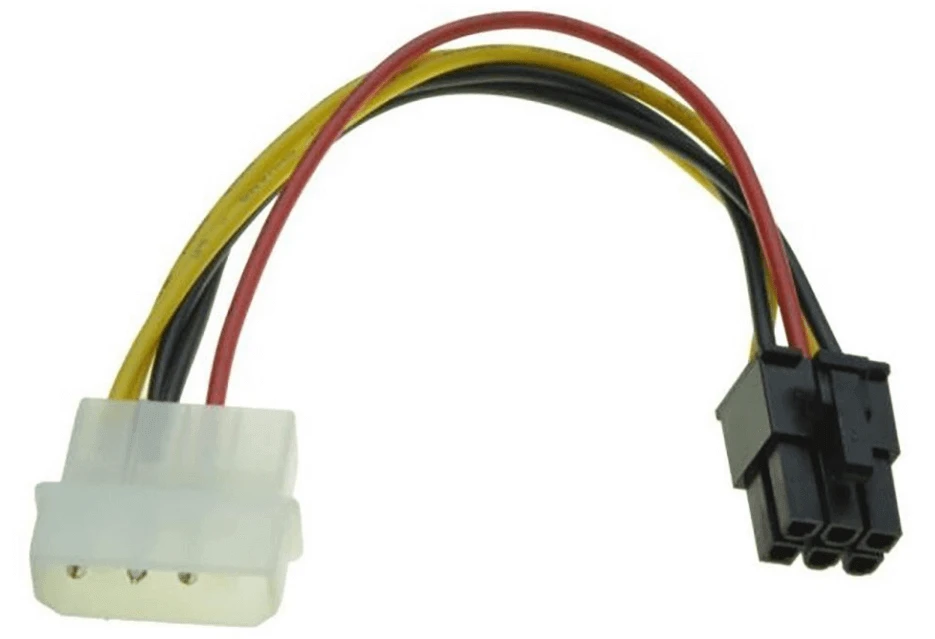
This adapter cable provides compatibility from a 4-pin Molex connector to a 6-pin PCIe GPU power cable. If the graphics card you want has a 6-pin connector and your power supply does not have one, you can use a 4-pin Molex to 6-pin GPU converter. Older power supplies are typically not pin-compatible with newer-generation video cards. So you need to upgrade your PSU or use a converter.
A 4-pin to 6-pin connector helps achieve compatibility with GPUs. Additionally, the 4-pin Molex power connector is the most standard type of connector available today and is used on all PATA and hard drives. A pin header usually has four Molex pins in an adapter or converter cable. This conversion cable connects to a 6-pin GPU to connect an external power supply.
2. 4-Pin Molex To 8-Pin PCI-E Power Adapter Cable
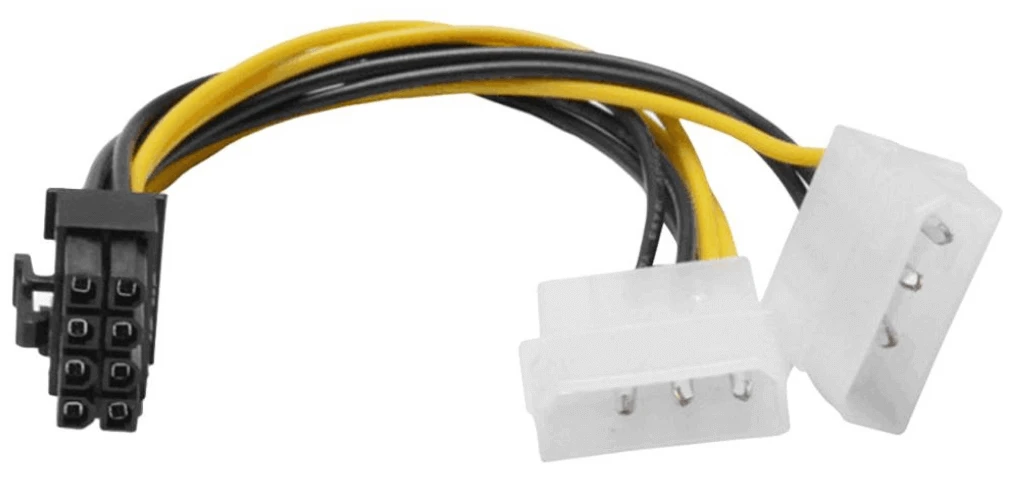
If your standard power supply has a 4-pin Molex connector and is not compatible with your next-generation graphics system, this conversion cable will help ensure compatibility. A 4-pin Molex to 8-pin PCIe adapter cable connects one end to a 4-pin Molex connector. The other end connects to an 8-pin GPU for an external power supply of 150W.
The 8-pin GPU converts power from the Molex pins and sends it to the GPU. The 4-pin Molex to 8-pin PCIe power adapter cable is ideal for all power supplies that integrate with mid-range and high-end GPUs.
3. 6-Pin To 8-Pin PCI-E Adapter Cable
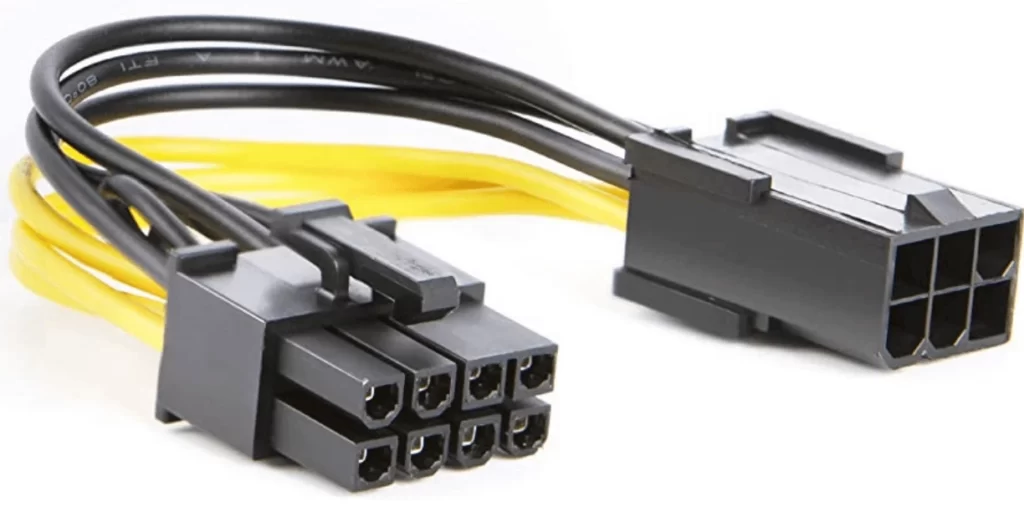
If you recently purchased a GPU with an 8-pin PCIe adapter. However, the PSU does not have an 8-pin connector. Instead, it has a 6-pin connector. In such cases, a PCI-E 6-pin to 8-pin adapter cable allows you to connect a 6-pin to 8-pin PCIe connector. Suppose you are using an 18 AWG adapter cable. You can immediately expect up to 300 watts of power from an external power supply.
A 6-pin cable consumes 75 watts of power, and an 8-pin PCIe cable consumes an additional 150 watts. 6-pin to 8-pin adapter cables are usually reserved for high-end GPUs. So if your PSU doesn’t have an 8-pin connector to support a high-performance GPU, you can use a PCIe 6-pin to 8-pin adapter.
4. 2x 8-Pin To 12-Pin PCI-E Adapter Cable

As mentioned in the previous section of this editorial, the 12-pin GPU power connector is the latest technology used in the case of GPUs. The 12-pin header delivers over 500W of power, meeting the requirements of most high-end GPUs. This includes NVIDIA 3000 series graphics cards such as 3090, 3080, 3070, and 3060.
However, NVIDIA’s 12-pin GPUs have only recently been launched, so not many power supplies developed have 12-pin PCIe connectors. Most connectors on standard power supplies include dual 8-pin PCIe connectors or 16-pin PCIe connectors. That’s why NVIDIA offers an 8-pin PCIe to 12-pin PCIe adapter cable. This adapter offers compatibility with all modern GPUs.
5. SATA to 6-Pin PCI-E Adapter Cable
SATA has replaced the PATA connector. Previously, PATA connectors had 34-40 pins, so they were replaced with SATA connectors to save space. These types of connections are designed to provide high-speed data transfer to storage devices, optical drives, and graphics devices. However, SATA is now obsolete.
This is common with older PSUs, but modern PSUs use PCIe connectors. If you have a SATA connector and want to be compatible with a 6-pin GPU, you can use a SATA to PCI-E 6-pin adapter cable. This power adapter cable offers SATA compatibility and consumes over 150W of power to your GPU.
6. SATA to 8-Pin PCI-E Adapter Cable

The SATA to 8 pin PCIe adapter cable provides compatibility with 8 pin GPU power cables. Most older PSUs have 4-pin SATA connectors, so one 8-pin PCIe connector requires a 2-pin SATA connector. This adapter helps you connect and get 225W of power to your GPU.
Purchase one connector cable for each 4-pin SATA connector.
Essential Things That You Need To Know About Adapter Cables And Connectivity
If your PSU is too old and doesn’t have a connector, we recommend upgrading your PSU. Because; the old PSU has an old configuration. Designed to meet the power requirements of past power supplies. However, the modern power requirement scenario is quite different.
New generation graphics cards consume a lot of power and require higher power directly from external sources. So you need to upgrade your PSU to give your GPU the power it needs.
However, if you still want to decide whether to connect an adapter, you should consider connecting a Molex to a Molex connector. SATA-Molex connector cables do not meet power transfer standards. Older Molex cables are pretty poorly rated. Therefore, the more power your GPU consumes, the more it will start to burn or create a fire hazard.
Frequently Asked Questions (FAQs)
1. What Are GPU Power Connectors Called?
GPU power connectors are commonly known as PCI Express cables or PEG cables. A PCIe Express cable is also known as a 6-pin connector. However, motherboard power connectors are known as PCIe connectors. Each computer/power supply has PCIe x2, 4, 8, and 16 slots.
A slot here represents a track. The more lanes found, the faster the data transfer. PCIe x16 sees 16 bits of data transfer per cycle. Older PSUs have Molex connectors. After Molex, the connector was eventually replaced by PATA and SATA.
2. Can I Plug A 6-Pin Into An 8-Pin GPU?
Connecting a 6-pin power supply to an 8-pin GPU comes with many risks and potentially a fire hazard. Because; connecting a 6-pin power supply to an 8-pin GPU will try to draw a lot more power than the cable is rated for. In such cases, the cable may start a fire. Additionally, all important data may be deleted.
So it makes more sense to upgrade your PSU than plugging a 6-pin header into an 8-pin GPU. For game settings, the system may suddenly crash. However, if you want to connect a 6-pin power supply to an 8-pin GPU, follow these steps:
Make sure you do this under supervision after learning all about installation. When connecting, first turn off the power, remove the power panel, remove the screw of the old GPU, and pull out the cable built into the PCIe slot.
Now connect the 8-pin GPU connector to the 6-pin power supply, shorten the remaining two pins, and finally connect the power supply and turn it on for the test run.
3. How Do I Connect My GPU To My Power Supply?
Connecting the GPU to power isn’t too much of a hassle. You can do it yourself if you know how to set up your system. Follow the steps below to get it done quickly.
First, if you take the power supply out and unscrew the panel, you’ll find some wires and a screwdriver attached to the power supply. Next, you need to identify your motherboard, specifically the PCIe slot (the PCIe slot is where you connect your power supply). supply to major components)
There is a PCIe slot near the PC case/I/O shield. A typical PSU motherboard has 20 PCIe lanes, so it’s easy to spot. If you have an existing GPU, you’ll need to unplug the connector and unscrew it to get it out.
Now that we’ve pulled out the existing one, it’s time to install the new GPU. After installing the GPU, plug the GPU connector into the PCIe slot. If your slot is not compatible with your GPU socket, you can use an adapter to ensure compatibility.
Finally insert the pins into the connector and make sure everything is secure, then screw the panel back on and turn it on.
4. Do Power Connectors Come With GPU?
As a rule, the power connector required by the video card is always included with the power supply. However, GPUs are often more advanced than power supplies, so manufacturers provide power connectors and adapters to make them compatible with GPUs.
The latest example is the NVIDIA 3000 series, developed by NVIDIA, which comes with a 12-pin header that supplies the power required by the GPU.
5. Can A 6-Pin PSU Connect To An 8-Pin GPU Connector?
Yes! You can connect a 6-pin GPU to an 8-pin header. But you have to do it right. Mistakes can lead to fires, but upgrading or replacing cables is always wise.
Reasons why you should avoid connecting a 6-pin GPU to an 8-pin GPU:
A 6-pin GPU plugged into an 8-pin header draws more power than expected. This can strain your power supply and cause your system to crash and wipe out all your data. Therefore, it is recommended to replace the power supply with an upgraded one.
Conclusion
In conclusion, these are the differences you should know about 6-pin, 8-pin, and 12-pin connectors. You also learned the easy ways to connect to GPUs and the differences. But in addition to that, we also have to consider the consequences that we may face with the connection.
If no compatibility is found, we recommend upgrading your PSU. If you need further advice or suggestions, you can leave a comment in the comments section below. This editorial hopefully helps you find the best GPU power connector and choose the right one.
Recommendation: In-depth guide on Crypto Mining with the advantages and disadvantages. 10 Best Mining Rig Frames For Crypto Mining Setup In 2022 [Top] 8 Best Risers for Mining with Your GPU in 2022 RTX 3060 Ti Mining Profitability Setup in 2022 For effective Crypto Mining Best GPU for mining profit 2022 #Ethereum & #Altcoins Mining (with Pros & Cons) 10 Best Mining Frame /Mining Rig frame for Crypto Mining Setup in 2022 6 Best Motherboard for Ethereum Mining 2022 – Comprehensive Review Recommendation: Monitors to look at; 10 Best Cheap 240hz Gaming Monitors Reviewed By Mr. Wackadoo-Cheapest 240hz Monitors in 2022 7 Best Monitor For Xbox Series X – Fastest Gaming Monitor for Competitive Gamers Recommendation: Games to look at; Top 23 Best AA Games You Should Play Right Away| low budget games pc Top 25 FREE Single Player Games of All Time TOP 24 Open World Best Games on PC Today, Ranked by Mr. Wackadoo Dragon Age 4 release date, story, gameplay, and everything else so far Before the Blood| Announce Trailer| PC debut| Before the Blood Game on Steam— Enter Yes™ Recommendation: RTX graphics card chipset to look at; Best RTX 3070 Graphics Cards of 2021 Top GPUs-Best Graphics Cards for Gaming in 2021–2022 Best 2022 GeForce RTX 3080 Amazon Graphics Cards, Check Out Today’s Best Deal Best Gaming Headsets for PS4 and PS5 in 2022 and beyond List Of Best RGB Keyboards To Buy In 2021 and beyond
